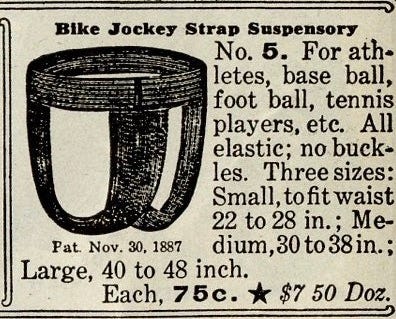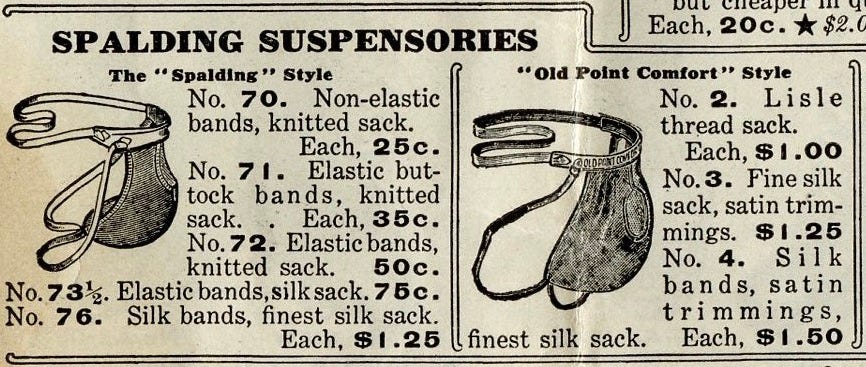Today's Tidbit... Early Jocks and Abdomen Protectors (aka Cups)
Football Archaeology has covered many aspects of the clothing and equipment worn by early football players but has never written about one of football’s most important pieces of equipment, the jock.
“Jock” is the Scottish and Northern English diminutive of John, just as Jack or Jacky is the Southern English form. Jock and Jack also described men or boys generally, and a boy riding a horse was a jockey, so when bicycles came along in the 1800s, men who rode them were also called jockeys.
As painful as it may seem, early bicycles had wooden seats (without padding) that were often ridden on cobblestone or otherwise bumpy streets, resulting in their riders needing an undergarment to "keep themselves in place.” Since necessity is the father of invention, Chicago's C. F. Bennett designed a thong-like undergarment in 1874 that became known as a bike jockey strap, or jock. Twenty years later, Bennett started his own company, the Bike Web Company, to manufacture these useful garments, leading to Bike becoming the dominant brand name in the jock trade for more than a century.
The jock is a simple item with only one or two functions, so one might think Bennett could have designed the perfect jock the first time around, and this story would have ended right here, but that was not the case. Just as GM once had a brand for every budget, the world needed jocks at different price points and styles.
The Bike Jockey Strap shown above cost 75 cents in 1908. However, those who economized on this vital garment could pay 50 cents for elastic Models 2 and 3 or as little as 20 cents apiece for No. 1, a flannel version, which looks much like cotton briefs without the hide-and-seek opening in front.
The market also demanded the Spalding and Old Point Style suspensories at the short and long end of the financial spectrum. Akin to a thong one might see on a beach today -hopefully, worn by someone who looks nothing like an offensive guard- they cost as little as 25 cents or as much as six times that, depending on your choice of fabrics for the sack and bands.
The jocks covered so far have included only those units supporting the wearer's unit, not those providing mechanical protection. Those babies, called abdomen protectors, which protected the abdomen only if worn incorrectly, became known as cups or lifesavers, depending on the league you played in. Then, as now, they were primarily worn by players with higher grade point averages.
One version of the abdomen protector came in well-padded sole leather and cost a princely $3.00 (approximately $100 in 2023), while the top model, made of aluminum, rang up at $3.50. The economy model cost only $2.00 and was made mainly of wire. The latter seems like it would have been exceedingly uncomfortable, despite being worn over a regular jock strap.
Of course, we can't end our discussion of early jocks without mentioning that the term spilled over and became synonymous with male athletes in 1963. (The earliest use I found was a UNC Daily Tar Heel article from February 1963 describing various social groups on campus, one of which was the jocks.)
While the jock began supporting athletes around the time gridiron football began, it remained a vital part of football gear for 100+ years until tight-fitting shorts supplanted the conventional jock. Perhaps "jock" as a term for athletes will fall from use in the future. But, if so, what word will take its place? Surely, “shorty” would not be an acceptable name.
Football Archaeology is reader-supported. Click here to buy one of my books or otherwise support the site.






Always did wonder...